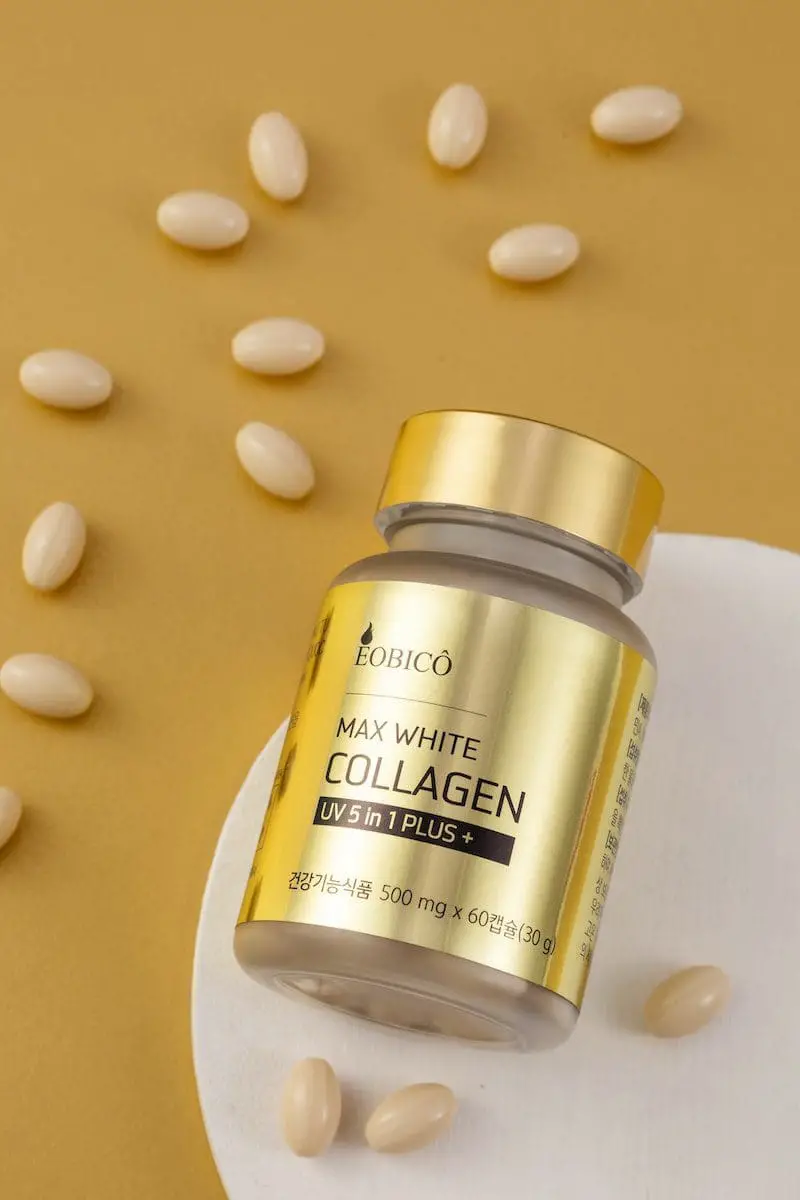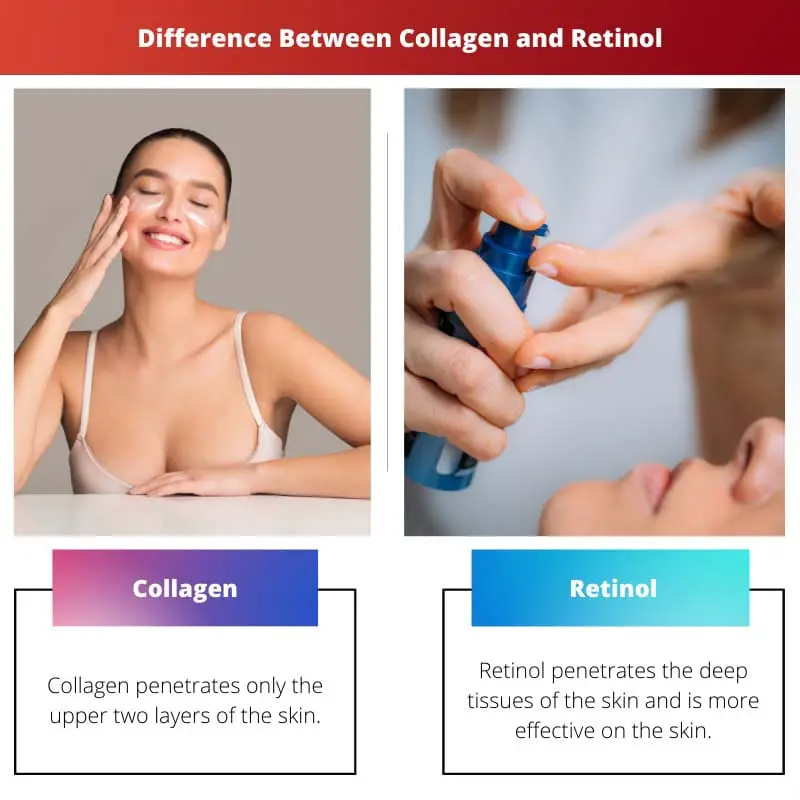Nowadays, almost every beauty cream contains a significant amount of Collagen and Retinol, but most people don’t know how they both work on the skin. Is there any significant difference between Collagen and Retinol?
No wonder both of them are chemical properties also produced by our body cells up to certain age in females. Moving further, we have penned down their uses for different purposes.
Key Takeaways
- Collagen is a structural protein that provides strength and elasticity to the skin, while retinol is a vitamin A derivative that stimulates cell turnover and collagen production.
- Collagen supplements and creams aim to replenish lost collagen in the skin, while retinol products focus on boosting collagen synthesis.
- Retinol can have side effects like irritation and sensitivity, whereas collagen products are well-tolerated.
Collagen vs Retinol
Collagen is a protein that is a major component of connective tissue in the body, providing strength and elasticity to the skin, bones, muscles, tendons, and other tissues. Retinol is a form of vitamin A and a powerful antioxidant that is used in skincare products to promote healthy skin.

The term Collagen refers to the structural protein located in connected tissue. It repairs the temporary damage to the skin overnight. Also, It slows down the signs of ageing in the skin.
Both Biochemical substances and structured proteins are the properties of Collagen. In large quantities, Collagen is present in the corneas, the gut, intervertebral discs, blood vessels, and the dentin in teeth.
The term Retinol refers to the purest form of Vitamin A present in the human body to repair the damaged tissues in the skin and make the skin flawless.
It stimulates the new productive skin cells, and in addition to the same, it is much stronger than Collagen on the skin. Vitamin A1 is prominently referred to as Retinol since it has gained popularity in skin products.
Comparison Table
| Parameters of Comparison | Collagen | Retinol |
|---|---|---|
| Effects | Collagen penetrates only the upper two layers of the skin. | Retinol penetrates the deep tissues of the skin and is more effective on the skin. |
| Structure. | The structure of Collagen is a helix created from polypeptides. | The structure of Retinol is fat-soluble alcohol. |
| Formation | It is created from the Fibroblast cells which form Collagen. | Formation of Retinol can be with the intake of carotenoids in food. |
| Demerits. | The Collagen has the risk of Ehlers-Danlos syndrome to a person. | Retinol has the risk of health issues if taken too much in food. |
| Weight or Mass. | The molecular weight of Collagen is about 300000 g/mol. | The molecular weight of Retinol is about 286,45 g/mol. |
What is Collagen?
The Collagen has a helical-shaped structure consisting of three chains of protein subunits and some covalent bonds.
There are many types of Collagen found in the human body forming many skin tissues and repairing the skin temporarily. It is essential protein-making tissue of the body which heals the upper two layers of skin.
It is a very important part of the skin cells that do not break down easily and has some flexible properties. It is created with the help of special cells in the body prominently known as Fibroblasts.
The combination of proline, lysine, sugars, and hydroxyl groups bonded together form fibroblast cells in the body that produce collagen protein.
Collagen is a structural protein found in the extracellular matrix located in various connected tissues of the skin, and it is less effective on the skin as compared to Retinol.
It is the main component of connected tissues in the body. It makes up or produces about 25% to 35 % protein in a person.
In the structure of Collagen, mainly the amino acids which are bonded together are helix formation. They are included in the cartilage, bones, tendons, ligaments, and skin. The forms of Collagen and rigid and compliant.

What is Retinol?
Retinol refers to a type of Vitamin A1 present in skincare products to slow the ageing process in women.
There are many types of Retinols present in the market, and before starting to use them over the skin, one must take advice from a dermatologist.
An initially mild version of Retinol should be applied to the skin to avoid harming the human skin.
It is found in various food items containing Vitamin A and also treats the deficiency of Vitamin A in the human body. A very important use of Retinol is as a dietary supplement.
It cures acne and other chronic skin conditions that leave skin spots, specifically on the face. Prevention of abnormal skin peeling and pigmentation can be removed with the help of Retinol.
An Individual with severe acne requires a high dose of Retinol in the skin.
Vitamin A is an unsaturated compound that contains Retinol and prevents skin ageing after 30 years of human life. Retinol tricks the body into thinking young. Skin turnovers the cells faster after intake of Retinol serum or gel.
A teenager can use Retinol at an early age for the treatment of acne spots and dark spots.

Main Differences Between Collagen and Retinol
- Strongness: Collagen is less harsh on the skin, whereas Retinol is harsher on the skin than Collagen.
- Usage: Collagen works on sensitive skin, and skin breaks out due to retinol on the other side, Retinol works on the elimination of deep wrinkles on the skin.
- Results: The results of Collagen are overnight or short-term on the contrary, Retinol gives long-term results on the skin.
- Benefits: Collagen gives flawless, plumpy skin, whereas Retinol softens the skin and makes skin tone lighter.
- Commercial Purpose: Collagen is used for skin surgeries and reconstruction, whereas Retinol is present in various Vitamin A supplements available over the counter.

- https://www.sciencedirect.com/science/article/abs/pii/S019096228670248X
- https://www.tandfonline.com/doi/abs/10.3109/09546639909056013

The article provides a comprehensive comparative analysis of Collagen and Retinol, which is quite helpful for individuals who are looking for specific skin treatments.
It is important to know the differences between these two components, as they are present in multiple skin care products. Understanding them will help in making an informed choice while purchasing beauty creams
Well said, Kevin01!
This is a valuable piece of information indeed
This article can be confusing for many readers who are not well-versed in scientific jargon,
The author’s explanation on how collagen and retinol work on the skin is laudable. The use of comparisons and examples is quite effective in communicating the differences between the two components.
The content is engaging and provides a valuable insight into the roles of Collagen and Retinol in skincare. It’s refreshing to see an in-depth analysis of these compounds.
The clarity of information about the differences in Collagen and Retinol is truly appreciated. I am better informed after reading this article.
The comparison table is quite helpful in distinguishing the differences between Collagen and Retinol. It’s a great resource for anyone looking to understand these compounds.
This is a well-researched article. The references provided add credibility to the content, making it a reliable source of information on Collagen and Retinol.
I appreciate the detailed information provided. It is quite helpful in understanding the uses and benefits of Collagen and Retinol.
While the scientific information is well-presented, it seems that practical implications are left out. For instance, the article should have discussed which skin products are most appropriate for different skin types.
An interesting comparison and useful to know the difference between Collagen and Retinol.
The explanation is thorough and very informative. The characteristics of each compound are well explained.